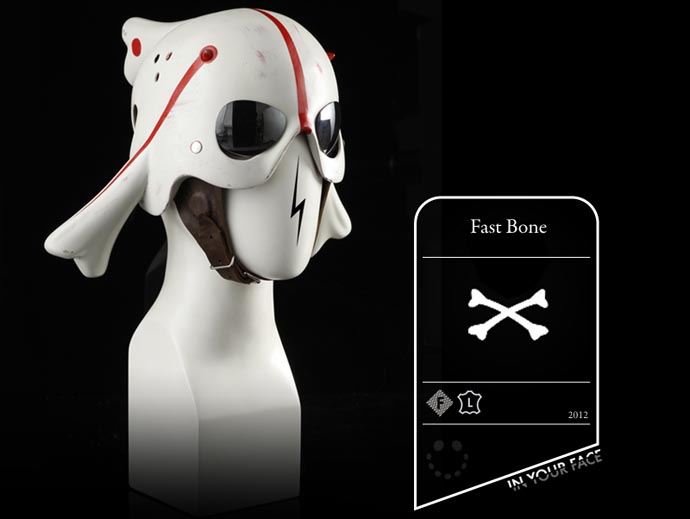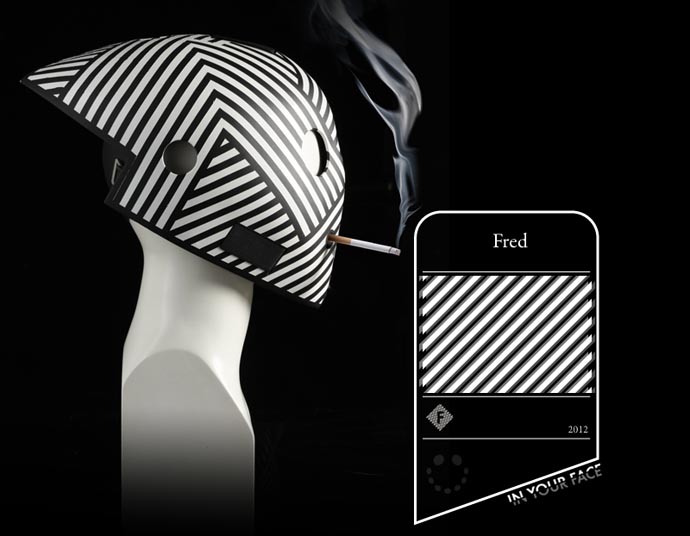Why do most cycle helmets look so boring? Most countries allow cyclists to decide for themselves whether or not to wear protective headgear, but there is very little choice when it comes to design. Exceptions to the rule include helmets designed to be covered by a hat and skateboard-style lids, but for the most part an additional air vent or an extended peak is enough to pass for cycle helmet innovation.
After all, if you decide to wear a helmet when you commute into town or pop to the shops, why must it look like something Bradley Wiggins would don to win the Tour de France? Style-conscious cyclists frustrated by run-of-the-mill headgear can seek inspiration from custom helmet maker smirkmasks.com. The website showcases a number of highly-original helmets and will undertake one-off commissions.
The designs are far more expensive and menacing than the standard polystyrene and plastic design you will be offered at your local bicycle shop, but since when was bespoke design cheap or pedestrian in appearance?
Ideal for Halloween? The mask/helmet below from smirkmasks.com features illuminated eyes…
Cycle insurance that’s anything but run-of-the-mill
Fully-comprehensive cover from the ETA costs from 39 per week and includes new-for-old, accidental damage, vandalism, £5m third party and Cycle Rescue – a breakdown recovery service for bicycles. Get an instant quote




Martin Bishop
While gimmicky helmets look like fun items, wearing a design with protrusions could prove fatal!
During any impact, the protrusions (like the bones on the Fast Bone helmet design above) will twist the helmet, and the head within it, when worn properly. In extreme cases, they could cause a broken neck!
ETA should be responsible and warn about such risks rather than assume that every reader has the common sense to realise that these are joke items and make lttle practical contribution to the safety of the wearer.
Keep up the good work.
Yannick Read
Hello Martin
You’re right to suggest that rigid protrusions pose a danger. In fact, as you will know, there is an argument that even conventional cycle helmet designs increase the risk of such rotational head injuries. As for our readers rushing out to buy these particular novelty helmets, they cost over 1,000 euros a piece…
Anthony Cartmell
Cycle helmets tend to look all the same because they all have to pass the same certification tests, and because they all try to pass the impact tests while weighing as little as possible and having as much ventilation as possible. So helmets generally only just pass the test: equivalent impact to falling off your bike at a slow speed. Providing more protection than the test requires results in the helmet being heavier and less ventilated than the competition, or needing to use much more expensive materials.
One thing that isn’t tested (but is for motorcycle helmets) is the increased twisting forces the helmet applies to your head in a crash. A motorcycle helmet is specifically designed to slide rather than twist your head, for obvious reasons. While cycle crashes are usually at slower speeds, sudden head twisting is particularly dangerous – potentially leading to dangerous “diffuse” brain injury and/or a broken neck.
I suspect, however, that these are custom masks or hats and not helmets 🙂
Yannick Read
Hi Anthony
As you point out, helmets have to adhere to regulations but it feels like there is a lack of innovation – in terms of both aesthetics and technology. Of course there are exceptions. There is an cyclist’s airbag that is worn as a collar and there may soon be helmets available for sale that feature a synthetic scalp to reduce the risk of rotational head injuries. Existing cycle helmets are little more than polystyrene encased in a plastic shell – working in a similar way to the skull by protecting against direct blows – but they are not designed to mitigate rotational injuries, which can prove fatal. The British-designed Phillips Head Protection System behaves like a synthetic ‘scalp’. When it is struck, the surface of the helmet mimics the way the human scalp slides over the skull in the event of a blow, thereby reducing the risk of serious rotational head injuries. A conventional helmet is more inclined to ‘grip’ the surface that has been struck and cause the head and neck to twist.
You are right to suspect that the designs above are helmets in the very loosest sense of the term!
Duncan Kay
Am I not right in thinking that as well as the skin of the scalp moving, human hair is a very effective way of helping your head to slide rather than twist in an impact? Perhaps we should all follow Dr Ian Walker’s example and wear long blonde wigs (over a helmet if the rider wishes).
Yannick Read
I can’t think of a reason why hair wouldn’t have that effect. I hear that wigs to wear over helmets are available at https://www.eta.co.uk/2011/04/01/safest-bicycle-helmet-has-built-in-wig/
Peter Simmons
Best not to fall off a bike in the first place. I don’t agree with helmets and never wear one or would. Have helmets saved the lives of any motorcycle riders? Governments exist to introduce a stream of regulations to restrict our lives. Hard blows to the skull, whether encased in a helmet or not, can cause brain damage from the brain hitting the skull, best to avoid the blow than ‘protect’ against it. Don’t all ‘protection devices’ just encourage more risk taking by encouraging a feeling of safety?
Ian Byrne
Some months ago the decorative plastic shell finally fell off my cycle just leaving the polystyrene shell (too much hanging off my rucksack on the tube). It’s not pretty, but is it any less safe (apart from the fact that if dragged across the ground expanded polystyrene may have slightly greater friction, but it now totally lacks any potentially sharp bits)? I have assumed that as it is still functional, I may as well continue using it.
Yannick Read
I imagine the outer plastic shell serves to protect the polystyrene from damage and the elements. According to Brian Walker, of helmet-testing lab Head Protection Evaluations, “expanded polystyrene, the principal material from which cycle helmets are manufactured and the bit that protects you, is
not known to deteriorate with age. However, you should avoid putting anything heavy on top of the helmet, or exposing it to unnecessary knocks. You will get greater useful life from a helmet if you: (a) reserve a safe storage place for it when not in use, preferably in a strong small box; and (b) if your helmet gets a good soaking, you allow it to dry out for as long as is practical, at a dry room temperature. Most manufacturers recommend that a helmet be changed after five years – a fair guideline, if you’re unsure about checking your helmet yourself.” Read the full article at http://cyclehelmets.org/papers/c2023.pdf
Adeybaby
I used to think like the chap above, but came to the conclusion that ANYTHING that would add to my chances of survival on a daily commute to work and back is worthwhile. I am not a fan of government regulations but would rather give myself that extra percentage, however small.